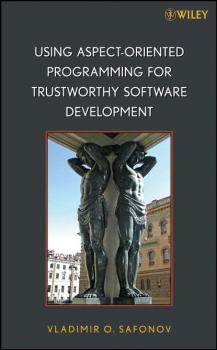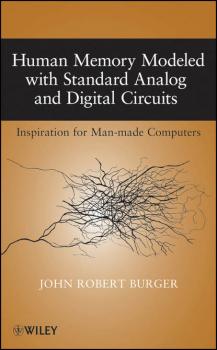ТОП просматриваемых книг сайта:
Группа авторов
Список книг автора Группа авторовАннотация
Smartphone Operating System Concepts with Symbian OS uses Symbian OS as a vehicle to discuss operating system concepts as they are applied to mobile operating systems.It is this focus that makes this tutorial guide both invaluable and extremely relevant for today's student.In addition to presenting and discussing operating system concepts, this book also includes exercises that compare and contrast Symbian OS, Unix/Linux and Microsoft Windows. These assignments can be worked on in a classroom laboratory or in a student's own time. The book is replete with examples (both conceptual and applied to handhelds) as well as: * Summaries at the end of each chapter. * Problems the students can do as homework. * Experiment-oriented exercises and questions for students to complete on a handheld device * A reading list, bibliography and a list of sources for handheld software It also contains a series of on-line laboratories based on the software developed for Symbian OS devices. Students can perform these labs anywhere, and can use printing and e-mail facilities to construct lab write-ups and hand in assignments. Students, for the first time, will be taught Symbian OS concepts so that they can start developing smartphone applications and become part of the mass-market revolution.
Аннотация
A guide to programming Symbian OS smartphones using OPL (The Open Programming Language): a simple to learn, open-source scripting language, ideal for fast-track development of enterprise applications. This book provides a hands-on development environment for both the experienced and aspiring programmer, demonstrating the ease of use of Symbian OS technologies through the utilization of OPL. OPL has a shallow learning curve which allows bespoke corporate tools to be developed in house by technical staff who aren’t necessarily trained programmers. Rapid Mobile Enterprise Development For Symbian OS provides a clear guide on both how to program, and understanding the structure of the language through a keyword dictionary. Any bespoke OPL application can grow with a company, eventually providing access to more advanced C++ code through OPX extensions. From the home programmer who wants to do more with their phone, to the enterprise developer, Rapid Mobile Enterprise Development For Symbian OS is the ideal starting point for simple, innovative application design using OPL. Source code is available from www.symbian.co.uk/books
Аннотация
The Sarbanes-Oxley Act requires public companies to implement internal controls over financial reporting, operations, and assets-all of which depend heavily on installing or improving information security technology Offers an in-depth look at why a network must be set up with certain authentication computer science protocols (rules for computers to talk to one another) that guarantee security Addresses the critical concepts and skills necessary to design and create a system that integrates identity management, meta-directories, identity provisioning, authentication, and access control A companion book to Manager's Guide to the Sarbanes-Oxley Act (0-471-56975-5) and How to Comply with Sarbanes-Oxley Section 404 (0-471-65366-7)
Аннотация
Future generations of vital signs and point-of-care medical devices must interoperate directly and seamlessly with information technology systems to facilitate effective patient care management within the healthcare enterprise. This is the first book addressing medical device integration with the computer-based patient record in a holistic way. Readers step into the area of two-way device communication & control and learn best practises from an author known for his brilliant expertise in this field. It is a fundamental guide for a broad group of people: clinical and biomedical engineers, physicians, bioinformatics practitioners, and vendors. Providing the essential how-to for medical device integration into the electronic medical record (EMR), health information system (HIS), and computerized patient record (CPR), the book highlights information on data extraction, usually not offered by device vendors. This comprises topics such as the use of third-party software, information on what to do when you develop interfaces on your own, regulatory issues, and how to assure connectivity and access to data. For physicians, it is a primer and knowledge manual for data integration when applied to clinical care and trials. It gives information on knowledge management and how data can be used statistically and as a tool in patient care management. Furthermore, it impresses upon the reader the quantities of data that must be processed and reduced to make for effective use at the point of care. HIS and CPR vendors may learn how data integration can be simplified and how software developers may be assisted in the process of communicating vital information to their repositories. The book is rounded off by a chapter on the future of integration.
Аннотация
Jossey-Bass Guides to Online Teaching and Learning Learning Online with Games, Simulations, and Virtual Worlds Strategies for Online Instruction Clark Aldrich Learning Online with Games, Simulations, and Virtual Worlds The infusion of games, simulations, and virtual worlds into online learning can be a transforming experience for both the instructor and the student. This practical guide, written by education game expert Clark Aldrich, shows faculty members and instructional designers how to identify opportunities for building games, simulations, and virtual environments into the curriculum; how to successfully incorporate these interactive environments to enhance student learning; and how to measure the learning outcomes. It also discusses how to build institutional support for using and financing more complex simulations. The book includes frameworks, tips, case studies and other real examples, and resources. Praise for Learning Online with Games, Simulations, and Virtual Worlds «Clark Aldrich provides powerful insights into the dynamic arena of games, simulations, and virtual worlds in a simultaneously entertaining and serious manner as only he can. If you are involved with educating anyone, from your own children to classrooms full of students, you need to devour this book.» – Karl Kapp, assistant director, Institute for Interactive Technologies, Bloomsburg University «At a time when the technologies for e-learning are evolving faster than most people can follow, Aldrich successfully bridges the perceptual gap between virtual worlds, digital games, and educational simulations, and provides educators with all they really need to use this technology to enhance and enrich their e-learning experiences.» – Katrin Becker, instructor, Department of Computer Science and Information Systems, Mount Royal College, and adjunct professor of education, University of Calgary «I consider this a must-read for anyone engaged in or contemplating using these tools in their classrooms or designing their own tools.» – Rick Van Sant, professor of learning and technology, Ferris State University
Аннотация
Exploring Spirituality and Culture in Adult and Higher Education is written from the unique perspective of teacher, researcher, and author Elizabeth Tisdell who has extensive experience dealing with culture, gender, and educational equity issues in secular adult and higher education classrooms, and formerly in pastoral and religious education settings on college campuses. This important book discusses how spiritual development is informed by culture and how this knowledge is relevant to teaching and learning. For educators, an understanding of how spirituality is informed by culture, and how spirituality assists in meaning-making, can aid in their efforts to help their students' educational experiences become more transformative and culturally relevant.
Аннотация
A practical guide to Cryptography and its use in the Internet and other communication networks. This overview takes the reader through basic issues and on to more advanced concepts, to cover all levels of interest. Coverage includes all key mathematical concepts, standardisation, authentication, elliptic curve cryptography, and algorithm modes and protocols (including SSL, TLS, IPSec, SMIME, & PGP protocols). * Details what the risks on the internet are and how cryptography can help * Includes a chapter on interception which is unique amongst competing books in this field * Explains Public Key Infrastructures (PKIs) – currently the most important issue when using cryptography in a large organisation * Includes up-to-date referencing of people, organisations, books and Web sites and the latest information about recent acts and standards affecting encryption practice * Tackles the practical issues such as the difference between SSL and IPSec, which companies are active on the market and where to get further information
Аннотация
Learn how to successfully implement trustworthy computing tasks using aspect-oriented programming This landmark publication fills a gap in the literature by not only describing the basic concepts of trustworthy computing (TWC) and aspect-oriented programming (AOP), but also exploring their critical interrelationships. The author clearly demonstrates how typical TWC tasks such as security checks, in-and-out conditions, and multi-threaded safety can be implemented using AOP. Following an introduction, the book covers: Trustworthy computing, software engineering, and computer science Aspect-oriented programming and Aspect.NET Principles and case studies that apply AOP to TWC Coverage includes Aspect.NET, the AOP framework developed by the author for the Microsoft.NET platform, currently used in seventeen countries. The author discusses the basics of Aspect.NET architecture, its advantages compared to other AOP tools, and its functionality. The book has extensive practical examples and case studies of trustworthy software design and code using the Aspect.NET framework. In addition, the book explores other software technologies and tools for using AOP for trustworthy software development, including Java and AspectJ. This book also includes a valuable chapter dedicated to ERATO, the author's teaching method employed in this book, which has enabled thousands of students to quickly grasp and apply complex concepts in computing and software engineering, while the final chapter presents an overall perspective on the current state of AOP and TWC with a view toward the future. Software engineers, architects, developers, programmers, and students should all turn to this book to learn this tested and proven method to create more secure, private, and reliable computing.
Аннотация
Gain a new perspective on how the brain works and inspires new avenues for design in computer science and engineering This unique book is the first of its kind to introduce human memory and basic cognition in terms of physical circuits, beginning with the possibilities of ferroelectric behavior of neural membranes, moving to the logical properties of neural pulses recognized as solitons, and finally exploring the architecture of cognition itself. It encourages invention via the methodical study of brain theory, including electrically reversible neurons, neural networks, associative memory systems within the brain, neural state machines within associative memory, and reversible computers in general. These models use standard analog and digital circuits that, in contrast to models that include non-physical components, may be applied directly toward the goal of constructing a machine with artificial intelligence based on patterns of the brain. Writing from the circuits and systems perspective, the author reaches across specialized disciplines including neuroscience, psychology, and physics to achieve uncommon coverage of: Neural membranes Neural pulses and neural memory Circuits and systems for memorizing and recalling Dendritic processing and human learning Artificial learning in artificial neural networks The asset of reversibility in man and machine Electrically reversible nanoprocessors Reversible arithmetic Hamiltonian circuit finders Quantum versus classical Each chapter introduces and develops new material and ends with exercises for readers to put their skills into practice. Appendices are provided for non-experts who want a quick overview of brain anatomy, brain psychology, and brain scanning. The nature of this book, with its summaries of major bodies of knowledge, makes it a most valuable reference for professionals, researchers, and students with career goals in artificial intelligence, intelligent systems, neural networks, computer architecture, and neuroscience. A solutions manual is available for instructors; to obtain a copy please email the editorial department at [email protected].
Аннотация
The Sarbanes-Oxley Act (SOX) was passed in 2002 in response to a series of high-profile corporate scandals and requires that public companies implement internal controls over financial reporting, operations, and assets; these controls depend heavily on installing or improving information technology and business methods Written by one of the most visible personalities on the tech-biz side of the SOX discussion, this highly readable, engaging book provides a clear road map for integrating SOX compliance into the fabric of everyday IT infrastructure and business practice Shows the reader how to leverage and use service-oriented architecture (SOA), a set of technologies that enables interoperation of heterogeneous computer systems, to achieve the level of internal controls over IT that SOX mandates










